Analysis of Management Accounting System Tools: Report on MAS
VerifiedAdded on 2022/10/10
|11
|3327
|272
Report
AI Summary
This report delves into the implications and relevance of Management Accounting Systems (MAS) in contemporary business environments. It begins by identifying and describing specific management accounting tools such as Balanced Scorecard, Just-in-time Inventory Technique, and Activity Based Costing. The report then assesses the relevance of MAS, using Company-A as a case study, focusing on the adoption of SAP R/3 and its applicability to different management levels. A comparative analysis is conducted between the findings of the initial case study and a second journal focusing on Enterprise Resource Planning (ERP) in Iranian companies, highlighting similarities and differences in their applications and effectiveness. The report further examines the importance of MAS in today's uncertain and competitive business landscape, emphasizing the need for adaptability and efficient data management. Finally, it concludes with lessons and outcomes drawn from both articles, offering valuable insights for Australian Management Accountants.
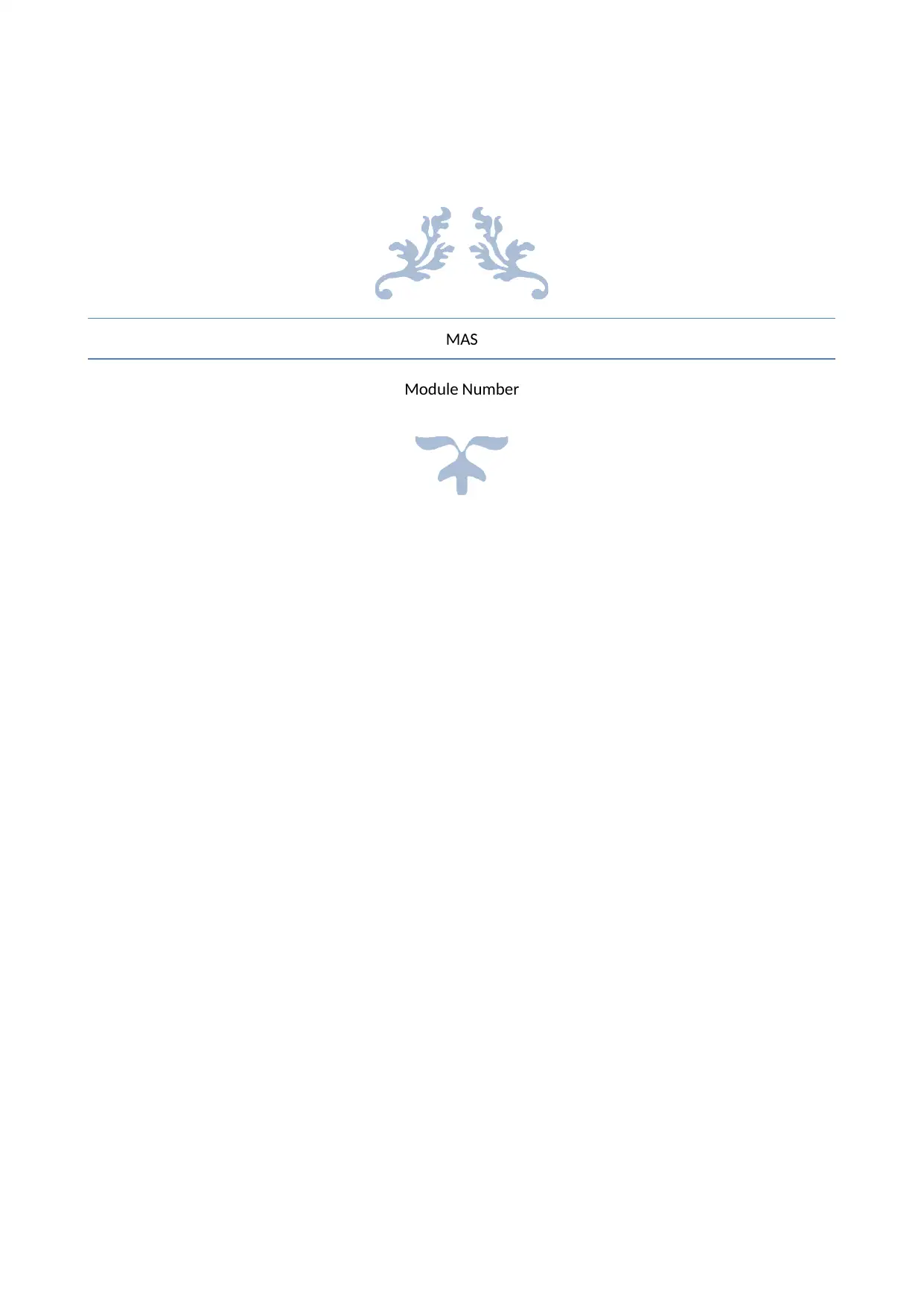
MAS
Module Number
Module Number
Paraphrase This Document
Need a fresh take? Get an instant paraphrase of this document with our AI Paraphraser
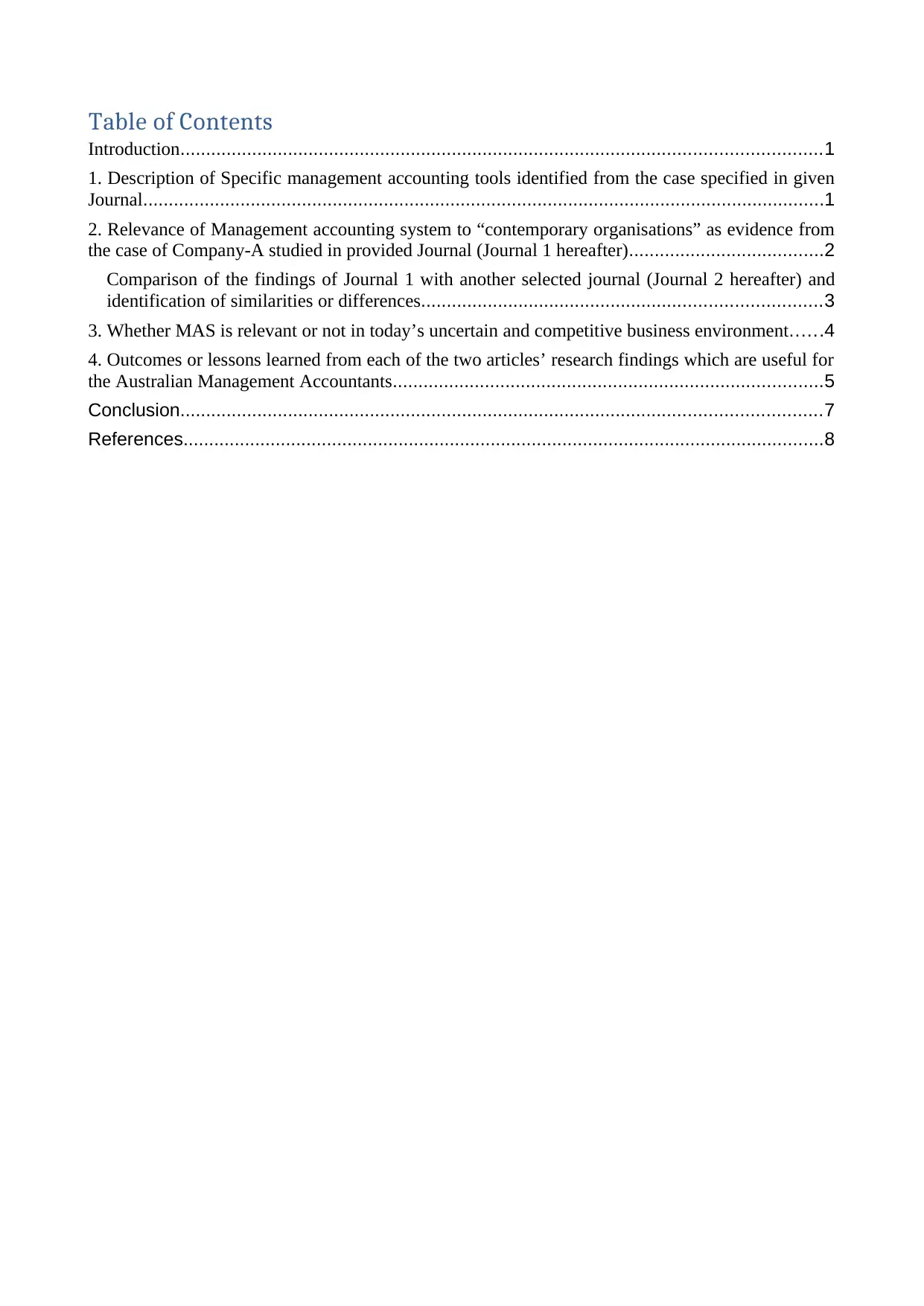
Table of Contents
Introduction.............................................................................................................................1
1. Description of Specific management accounting tools identified from the case specified in given
Journal.....................................................................................................................................1
2. Relevance of Management accounting system to “contemporary organisations” as evidence from
the case of Company-A studied in provided Journal (Journal 1 hereafter)......................................2
Comparison of the findings of Journal 1 with another selected journal (Journal 2 hereafter) and
identification of similarities or differences..............................................................................3
3. Whether MAS is relevant or not in today’s uncertain and competitive business environment......4
4. Outcomes or lessons learned from each of the two articles’ research findings which are useful for
the Australian Management Accountants....................................................................................5
Conclusion.............................................................................................................................7
References.............................................................................................................................8
Introduction.............................................................................................................................1
1. Description of Specific management accounting tools identified from the case specified in given
Journal.....................................................................................................................................1
2. Relevance of Management accounting system to “contemporary organisations” as evidence from
the case of Company-A studied in provided Journal (Journal 1 hereafter)......................................2
Comparison of the findings of Journal 1 with another selected journal (Journal 2 hereafter) and
identification of similarities or differences..............................................................................3
3. Whether MAS is relevant or not in today’s uncertain and competitive business environment......4
4. Outcomes or lessons learned from each of the two articles’ research findings which are useful for
the Australian Management Accountants....................................................................................5
Conclusion.............................................................................................................................7
References.............................................................................................................................8
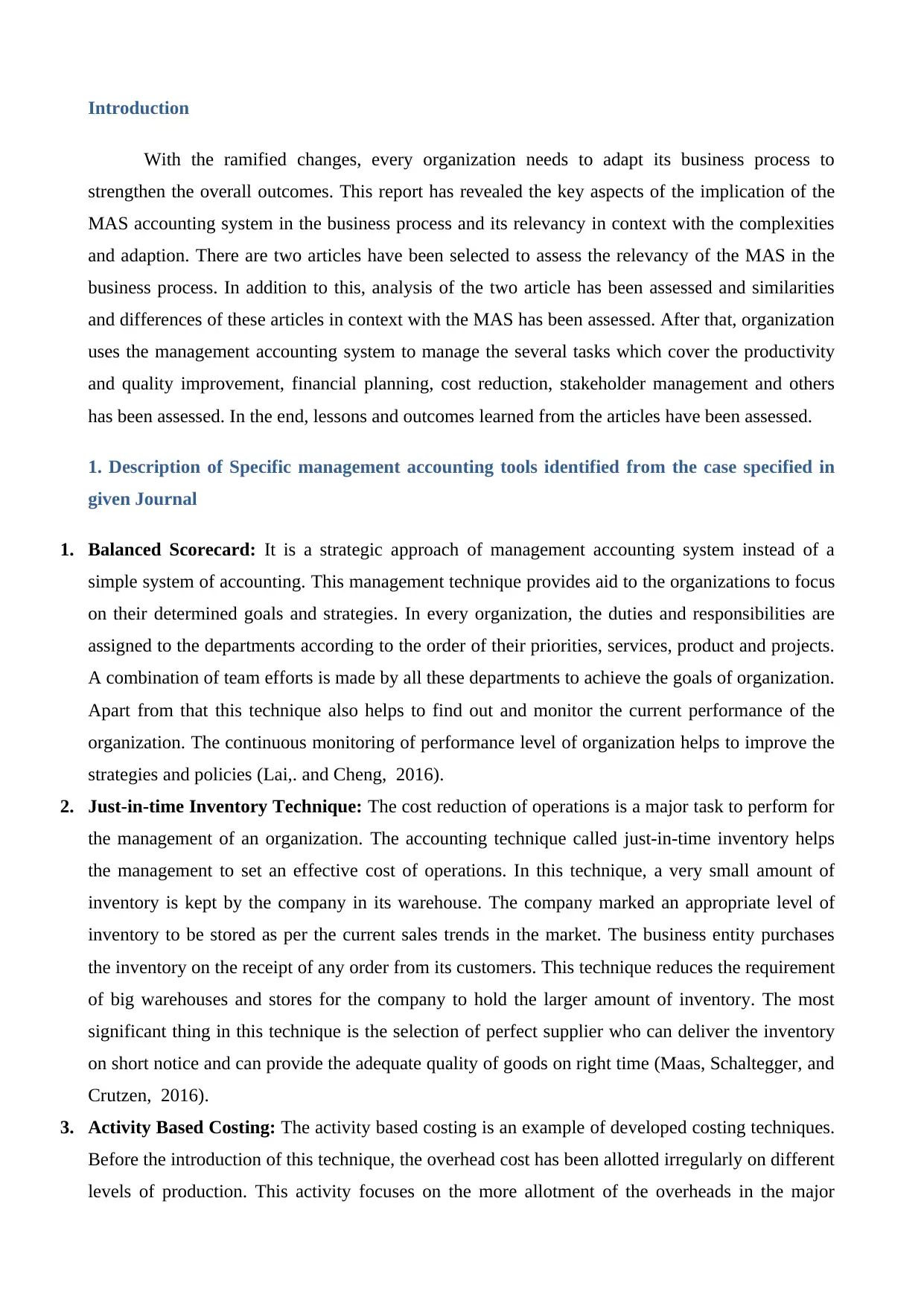
Introduction
With the ramified changes, every organization needs to adapt its business process to
strengthen the overall outcomes. This report has revealed the key aspects of the implication of the
MAS accounting system in the business process and its relevancy in context with the complexities
and adaption. There are two articles have been selected to assess the relevancy of the MAS in the
business process. In addition to this, analysis of the two article has been assessed and similarities
and differences of these articles in context with the MAS has been assessed. After that, organization
uses the management accounting system to manage the several tasks which cover the productivity
and quality improvement, financial planning, cost reduction, stakeholder management and others
has been assessed. In the end, lessons and outcomes learned from the articles have been assessed.
1. Description of Specific management accounting tools identified from the case specified in
given Journal
1. Balanced Scorecard: It is a strategic approach of management accounting system instead of a
simple system of accounting. This management technique provides aid to the organizations to focus
on their determined goals and strategies. In every organization, the duties and responsibilities are
assigned to the departments according to the order of their priorities, services, product and projects.
A combination of team efforts is made by all these departments to achieve the goals of organization.
Apart from that this technique also helps to find out and monitor the current performance of the
organization. The continuous monitoring of performance level of organization helps to improve the
strategies and policies (Lai,. and Cheng, 2016).
2. Just-in-time Inventory Technique: The cost reduction of operations is a major task to perform for
the management of an organization. The accounting technique called just-in-time inventory helps
the management to set an effective cost of operations. In this technique, a very small amount of
inventory is kept by the company in its warehouse. The company marked an appropriate level of
inventory to be stored as per the current sales trends in the market. The business entity purchases
the inventory on the receipt of any order from its customers. This technique reduces the requirement
of big warehouses and stores for the company to hold the larger amount of inventory. The most
significant thing in this technique is the selection of perfect supplier who can deliver the inventory
on short notice and can provide the adequate quality of goods on right time (Maas, Schaltegger, and
Crutzen, 2016).
3. Activity Based Costing: The activity based costing is an example of developed costing techniques.
Before the introduction of this technique, the overhead cost has been allotted irregularly on different
levels of production. This activity focuses on the more allotment of the overheads in the major
With the ramified changes, every organization needs to adapt its business process to
strengthen the overall outcomes. This report has revealed the key aspects of the implication of the
MAS accounting system in the business process and its relevancy in context with the complexities
and adaption. There are two articles have been selected to assess the relevancy of the MAS in the
business process. In addition to this, analysis of the two article has been assessed and similarities
and differences of these articles in context with the MAS has been assessed. After that, organization
uses the management accounting system to manage the several tasks which cover the productivity
and quality improvement, financial planning, cost reduction, stakeholder management and others
has been assessed. In the end, lessons and outcomes learned from the articles have been assessed.
1. Description of Specific management accounting tools identified from the case specified in
given Journal
1. Balanced Scorecard: It is a strategic approach of management accounting system instead of a
simple system of accounting. This management technique provides aid to the organizations to focus
on their determined goals and strategies. In every organization, the duties and responsibilities are
assigned to the departments according to the order of their priorities, services, product and projects.
A combination of team efforts is made by all these departments to achieve the goals of organization.
Apart from that this technique also helps to find out and monitor the current performance of the
organization. The continuous monitoring of performance level of organization helps to improve the
strategies and policies (Lai,. and Cheng, 2016).
2. Just-in-time Inventory Technique: The cost reduction of operations is a major task to perform for
the management of an organization. The accounting technique called just-in-time inventory helps
the management to set an effective cost of operations. In this technique, a very small amount of
inventory is kept by the company in its warehouse. The company marked an appropriate level of
inventory to be stored as per the current sales trends in the market. The business entity purchases
the inventory on the receipt of any order from its customers. This technique reduces the requirement
of big warehouses and stores for the company to hold the larger amount of inventory. The most
significant thing in this technique is the selection of perfect supplier who can deliver the inventory
on short notice and can provide the adequate quality of goods on right time (Maas, Schaltegger, and
Crutzen, 2016).
3. Activity Based Costing: The activity based costing is an example of developed costing techniques.
Before the introduction of this technique, the overhead cost has been allotted irregularly on different
levels of production. This activity focuses on the more allotment of the overheads in the major
⊘ This is a preview!⊘
Do you want full access?
Subscribe today to unlock all pages.

Trusted by 1+ million students worldwide
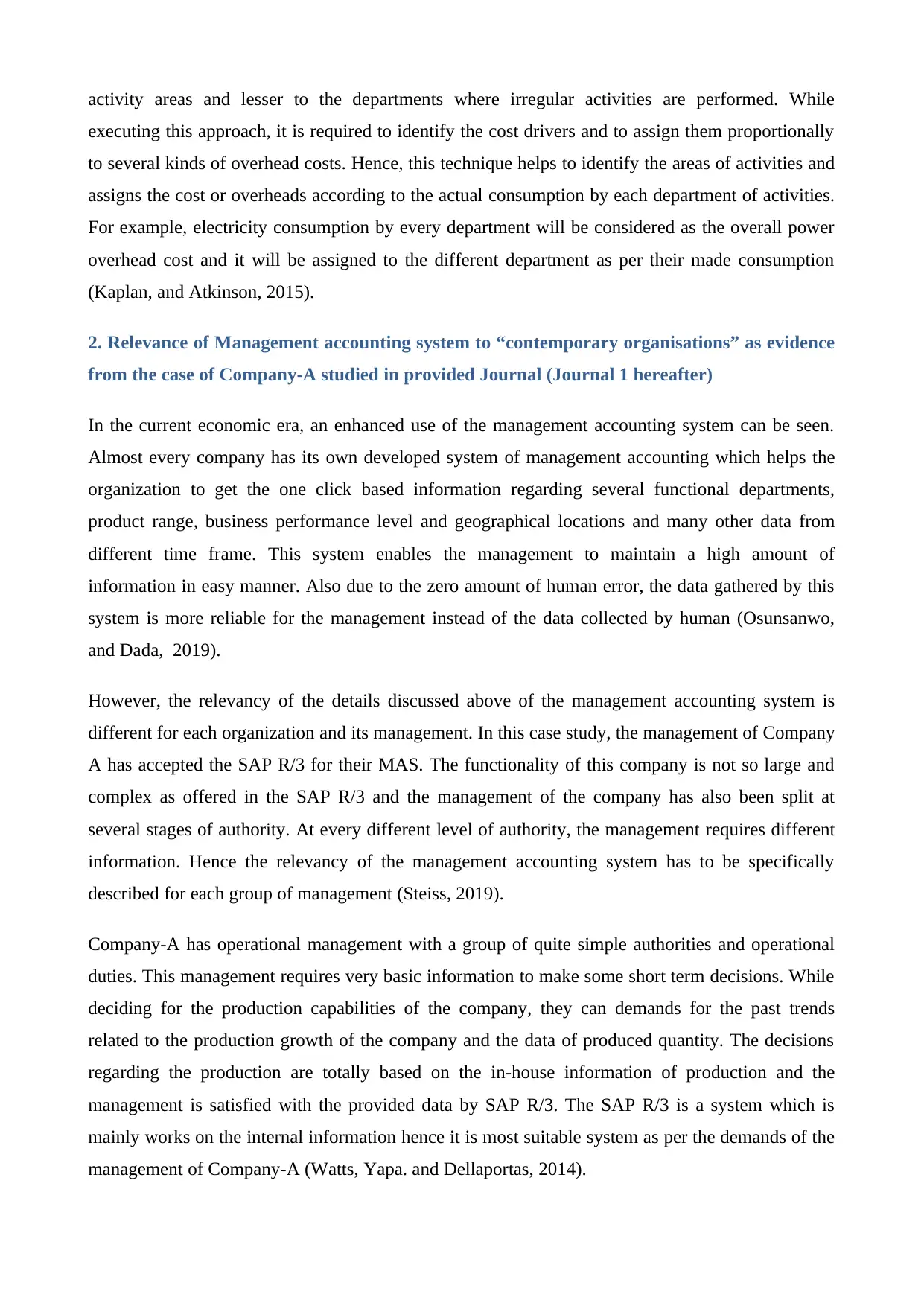
activity areas and lesser to the departments where irregular activities are performed. While
executing this approach, it is required to identify the cost drivers and to assign them proportionally
to several kinds of overhead costs. Hence, this technique helps to identify the areas of activities and
assigns the cost or overheads according to the actual consumption by each department of activities.
For example, electricity consumption by every department will be considered as the overall power
overhead cost and it will be assigned to the different department as per their made consumption
(Kaplan, and Atkinson, 2015).
2. Relevance of Management accounting system to “contemporary organisations” as evidence
from the case of Company-A studied in provided Journal (Journal 1 hereafter)
In the current economic era, an enhanced use of the management accounting system can be seen.
Almost every company has its own developed system of management accounting which helps the
organization to get the one click based information regarding several functional departments,
product range, business performance level and geographical locations and many other data from
different time frame. This system enables the management to maintain a high amount of
information in easy manner. Also due to the zero amount of human error, the data gathered by this
system is more reliable for the management instead of the data collected by human (Osunsanwo,
and Dada, 2019).
However, the relevancy of the details discussed above of the management accounting system is
different for each organization and its management. In this case study, the management of Company
A has accepted the SAP R/3 for their MAS. The functionality of this company is not so large and
complex as offered in the SAP R/3 and the management of the company has also been split at
several stages of authority. At every different level of authority, the management requires different
information. Hence the relevancy of the management accounting system has to be specifically
described for each group of management (Steiss, 2019).
Company-A has operational management with a group of quite simple authorities and operational
duties. This management requires very basic information to make some short term decisions. While
deciding for the production capabilities of the company, they can demands for the past trends
related to the production growth of the company and the data of produced quantity. The decisions
regarding the production are totally based on the in-house information of production and the
management is satisfied with the provided data by SAP R/3. The SAP R/3 is a system which is
mainly works on the internal information hence it is most suitable system as per the demands of the
management of Company-A (Watts, Yapa. and Dellaportas, 2014).
executing this approach, it is required to identify the cost drivers and to assign them proportionally
to several kinds of overhead costs. Hence, this technique helps to identify the areas of activities and
assigns the cost or overheads according to the actual consumption by each department of activities.
For example, electricity consumption by every department will be considered as the overall power
overhead cost and it will be assigned to the different department as per their made consumption
(Kaplan, and Atkinson, 2015).
2. Relevance of Management accounting system to “contemporary organisations” as evidence
from the case of Company-A studied in provided Journal (Journal 1 hereafter)
In the current economic era, an enhanced use of the management accounting system can be seen.
Almost every company has its own developed system of management accounting which helps the
organization to get the one click based information regarding several functional departments,
product range, business performance level and geographical locations and many other data from
different time frame. This system enables the management to maintain a high amount of
information in easy manner. Also due to the zero amount of human error, the data gathered by this
system is more reliable for the management instead of the data collected by human (Osunsanwo,
and Dada, 2019).
However, the relevancy of the details discussed above of the management accounting system is
different for each organization and its management. In this case study, the management of Company
A has accepted the SAP R/3 for their MAS. The functionality of this company is not so large and
complex as offered in the SAP R/3 and the management of the company has also been split at
several stages of authority. At every different level of authority, the management requires different
information. Hence the relevancy of the management accounting system has to be specifically
described for each group of management (Steiss, 2019).
Company-A has operational management with a group of quite simple authorities and operational
duties. This management requires very basic information to make some short term decisions. While
deciding for the production capabilities of the company, they can demands for the past trends
related to the production growth of the company and the data of produced quantity. The decisions
regarding the production are totally based on the in-house information of production and the
management is satisfied with the provided data by SAP R/3. The SAP R/3 is a system which is
mainly works on the internal information hence it is most suitable system as per the demands of the
management of Company-A (Watts, Yapa. and Dellaportas, 2014).
Paraphrase This Document
Need a fresh take? Get an instant paraphrase of this document with our AI Paraphraser
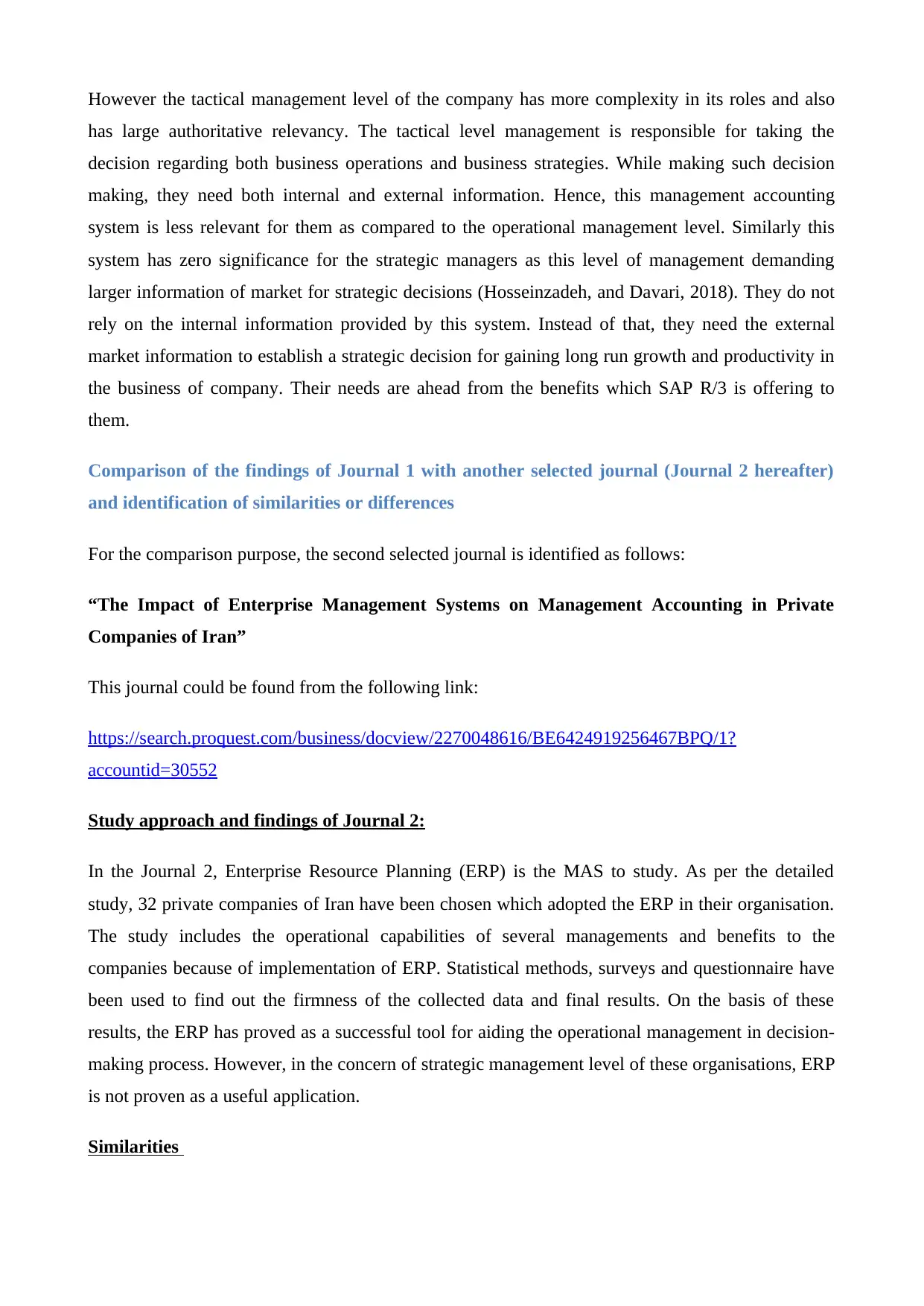
However the tactical management level of the company has more complexity in its roles and also
has large authoritative relevancy. The tactical level management is responsible for taking the
decision regarding both business operations and business strategies. While making such decision
making, they need both internal and external information. Hence, this management accounting
system is less relevant for them as compared to the operational management level. Similarly this
system has zero significance for the strategic managers as this level of management demanding
larger information of market for strategic decisions (Hosseinzadeh, and Davari, 2018). They do not
rely on the internal information provided by this system. Instead of that, they need the external
market information to establish a strategic decision for gaining long run growth and productivity in
the business of company. Their needs are ahead from the benefits which SAP R/3 is offering to
them.
Comparison of the findings of Journal 1 with another selected journal (Journal 2 hereafter)
and identification of similarities or differences
For the comparison purpose, the second selected journal is identified as follows:
“The Impact of Enterprise Management Systems on Management Accounting in Private
Companies of Iran”
This journal could be found from the following link:
https://search.proquest.com/business/docview/2270048616/BE6424919256467BPQ/1?
accountid=30552
Study approach and findings of Journal 2:
In the Journal 2, Enterprise Resource Planning (ERP) is the MAS to study. As per the detailed
study, 32 private companies of Iran have been chosen which adopted the ERP in their organisation.
The study includes the operational capabilities of several managements and benefits to the
companies because of implementation of ERP. Statistical methods, surveys and questionnaire have
been used to find out the firmness of the collected data and final results. On the basis of these
results, the ERP has proved as a successful tool for aiding the operational management in decision-
making process. However, in the concern of strategic management level of these organisations, ERP
is not proven as a useful application.
Similarities
has large authoritative relevancy. The tactical level management is responsible for taking the
decision regarding both business operations and business strategies. While making such decision
making, they need both internal and external information. Hence, this management accounting
system is less relevant for them as compared to the operational management level. Similarly this
system has zero significance for the strategic managers as this level of management demanding
larger information of market for strategic decisions (Hosseinzadeh, and Davari, 2018). They do not
rely on the internal information provided by this system. Instead of that, they need the external
market information to establish a strategic decision for gaining long run growth and productivity in
the business of company. Their needs are ahead from the benefits which SAP R/3 is offering to
them.
Comparison of the findings of Journal 1 with another selected journal (Journal 2 hereafter)
and identification of similarities or differences
For the comparison purpose, the second selected journal is identified as follows:
“The Impact of Enterprise Management Systems on Management Accounting in Private
Companies of Iran”
This journal could be found from the following link:
https://search.proquest.com/business/docview/2270048616/BE6424919256467BPQ/1?
accountid=30552
Study approach and findings of Journal 2:
In the Journal 2, Enterprise Resource Planning (ERP) is the MAS to study. As per the detailed
study, 32 private companies of Iran have been chosen which adopted the ERP in their organisation.
The study includes the operational capabilities of several managements and benefits to the
companies because of implementation of ERP. Statistical methods, surveys and questionnaire have
been used to find out the firmness of the collected data and final results. On the basis of these
results, the ERP has proved as a successful tool for aiding the operational management in decision-
making process. However, in the concern of strategic management level of these organisations, ERP
is not proven as a useful application.
Similarities
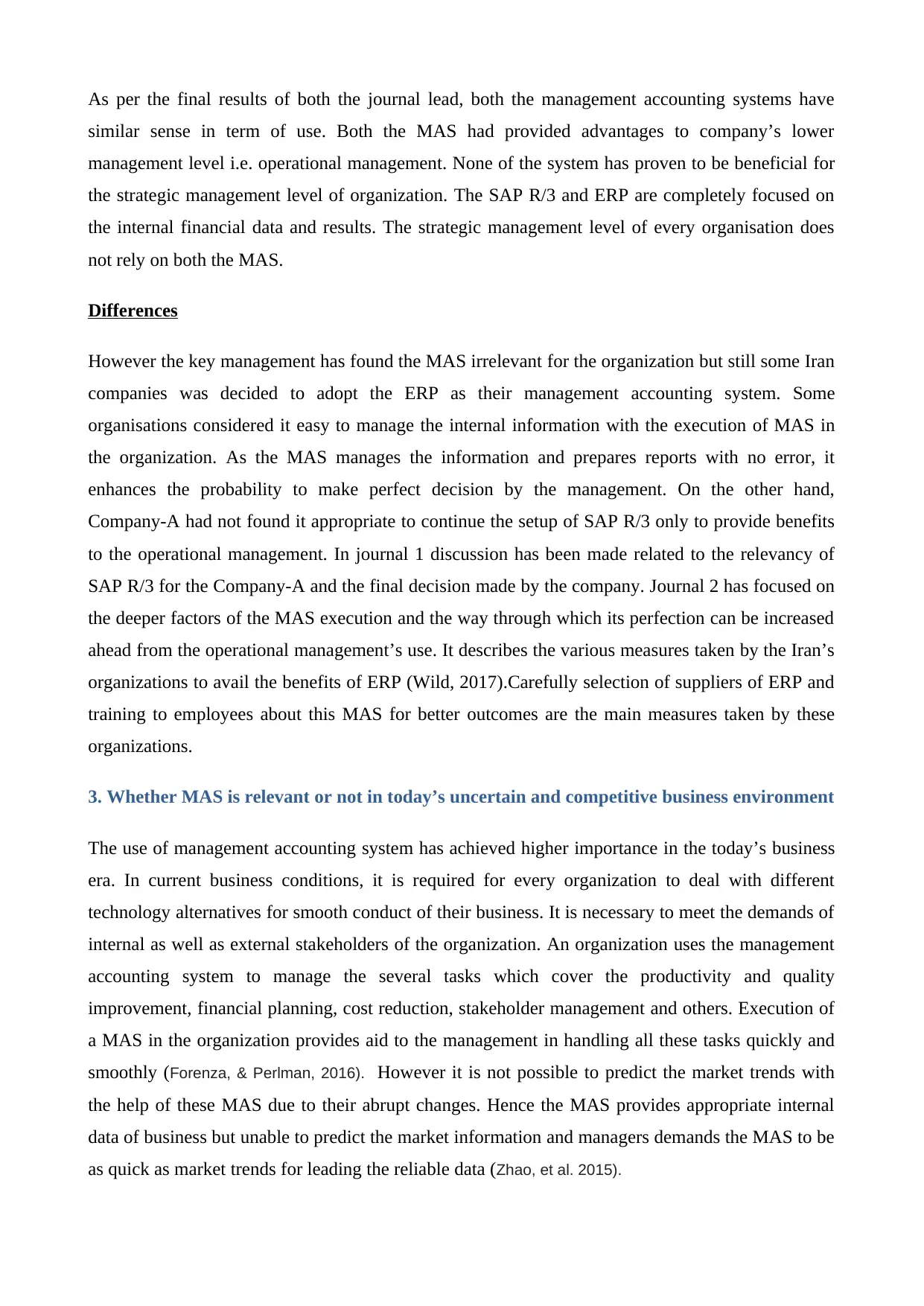
As per the final results of both the journal lead, both the management accounting systems have
similar sense in term of use. Both the MAS had provided advantages to company’s lower
management level i.e. operational management. None of the system has proven to be beneficial for
the strategic management level of organization. The SAP R/3 and ERP are completely focused on
the internal financial data and results. The strategic management level of every organisation does
not rely on both the MAS.
Differences
However the key management has found the MAS irrelevant for the organization but still some Iran
companies was decided to adopt the ERP as their management accounting system. Some
organisations considered it easy to manage the internal information with the execution of MAS in
the organization. As the MAS manages the information and prepares reports with no error, it
enhances the probability to make perfect decision by the management. On the other hand,
Company-A had not found it appropriate to continue the setup of SAP R/3 only to provide benefits
to the operational management. In journal 1 discussion has been made related to the relevancy of
SAP R/3 for the Company-A and the final decision made by the company. Journal 2 has focused on
the deeper factors of the MAS execution and the way through which its perfection can be increased
ahead from the operational management’s use. It describes the various measures taken by the Iran’s
organizations to avail the benefits of ERP (Wild, 2017).Carefully selection of suppliers of ERP and
training to employees about this MAS for better outcomes are the main measures taken by these
organizations.
3. Whether MAS is relevant or not in today’s uncertain and competitive business environment
The use of management accounting system has achieved higher importance in the today’s business
era. In current business conditions, it is required for every organization to deal with different
technology alternatives for smooth conduct of their business. It is necessary to meet the demands of
internal as well as external stakeholders of the organization. An organization uses the management
accounting system to manage the several tasks which cover the productivity and quality
improvement, financial planning, cost reduction, stakeholder management and others. Execution of
a MAS in the organization provides aid to the management in handling all these tasks quickly and
smoothly (Forenza, & Perlman, 2016). However it is not possible to predict the market trends with
the help of these MAS due to their abrupt changes. Hence the MAS provides appropriate internal
data of business but unable to predict the market information and managers demands the MAS to be
as quick as market trends for leading the reliable data (Zhao, et al. 2015).
similar sense in term of use. Both the MAS had provided advantages to company’s lower
management level i.e. operational management. None of the system has proven to be beneficial for
the strategic management level of organization. The SAP R/3 and ERP are completely focused on
the internal financial data and results. The strategic management level of every organisation does
not rely on both the MAS.
Differences
However the key management has found the MAS irrelevant for the organization but still some Iran
companies was decided to adopt the ERP as their management accounting system. Some
organisations considered it easy to manage the internal information with the execution of MAS in
the organization. As the MAS manages the information and prepares reports with no error, it
enhances the probability to make perfect decision by the management. On the other hand,
Company-A had not found it appropriate to continue the setup of SAP R/3 only to provide benefits
to the operational management. In journal 1 discussion has been made related to the relevancy of
SAP R/3 for the Company-A and the final decision made by the company. Journal 2 has focused on
the deeper factors of the MAS execution and the way through which its perfection can be increased
ahead from the operational management’s use. It describes the various measures taken by the Iran’s
organizations to avail the benefits of ERP (Wild, 2017).Carefully selection of suppliers of ERP and
training to employees about this MAS for better outcomes are the main measures taken by these
organizations.
3. Whether MAS is relevant or not in today’s uncertain and competitive business environment
The use of management accounting system has achieved higher importance in the today’s business
era. In current business conditions, it is required for every organization to deal with different
technology alternatives for smooth conduct of their business. It is necessary to meet the demands of
internal as well as external stakeholders of the organization. An organization uses the management
accounting system to manage the several tasks which cover the productivity and quality
improvement, financial planning, cost reduction, stakeholder management and others. Execution of
a MAS in the organization provides aid to the management in handling all these tasks quickly and
smoothly (Forenza, & Perlman, 2016). However it is not possible to predict the market trends with
the help of these MAS due to their abrupt changes. Hence the MAS provides appropriate internal
data of business but unable to predict the market information and managers demands the MAS to be
as quick as market trends for leading the reliable data (Zhao, et al. 2015).
⊘ This is a preview!⊘
Do you want full access?
Subscribe today to unlock all pages.

Trusted by 1+ million students worldwide
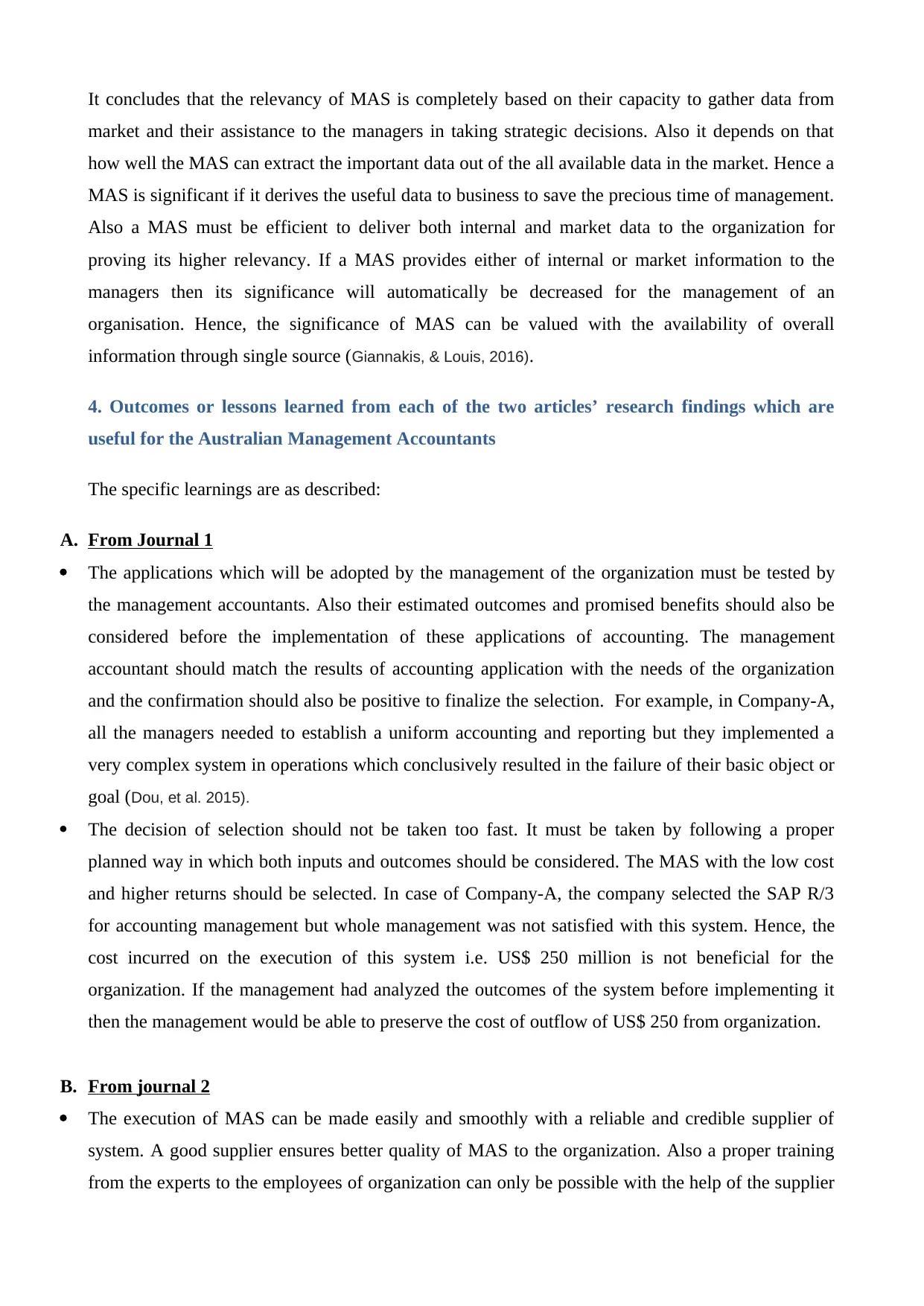
It concludes that the relevancy of MAS is completely based on their capacity to gather data from
market and their assistance to the managers in taking strategic decisions. Also it depends on that
how well the MAS can extract the important data out of the all available data in the market. Hence a
MAS is significant if it derives the useful data to business to save the precious time of management.
Also a MAS must be efficient to deliver both internal and market data to the organization for
proving its higher relevancy. If a MAS provides either of internal or market information to the
managers then its significance will automatically be decreased for the management of an
organisation. Hence, the significance of MAS can be valued with the availability of overall
information through single source (Giannakis, & Louis, 2016).
4. Outcomes or lessons learned from each of the two articles’ research findings which are
useful for the Australian Management Accountants
The specific learnings are as described:
A. From Journal 1
The applications which will be adopted by the management of the organization must be tested by
the management accountants. Also their estimated outcomes and promised benefits should also be
considered before the implementation of these applications of accounting. The management
accountant should match the results of accounting application with the needs of the organization
and the confirmation should also be positive to finalize the selection. For example, in Company-A,
all the managers needed to establish a uniform accounting and reporting but they implemented a
very complex system in operations which conclusively resulted in the failure of their basic object or
goal (Dou, et al. 2015).
The decision of selection should not be taken too fast. It must be taken by following a proper
planned way in which both inputs and outcomes should be considered. The MAS with the low cost
and higher returns should be selected. In case of Company-A, the company selected the SAP R/3
for accounting management but whole management was not satisfied with this system. Hence, the
cost incurred on the execution of this system i.e. US$ 250 million is not beneficial for the
organization. If the management had analyzed the outcomes of the system before implementing it
then the management would be able to preserve the cost of outflow of US$ 250 from organization.
B. From journal 2
The execution of MAS can be made easily and smoothly with a reliable and credible supplier of
system. A good supplier ensures better quality of MAS to the organization. Also a proper training
from the experts to the employees of organization can only be possible with the help of the supplier
market and their assistance to the managers in taking strategic decisions. Also it depends on that
how well the MAS can extract the important data out of the all available data in the market. Hence a
MAS is significant if it derives the useful data to business to save the precious time of management.
Also a MAS must be efficient to deliver both internal and market data to the organization for
proving its higher relevancy. If a MAS provides either of internal or market information to the
managers then its significance will automatically be decreased for the management of an
organisation. Hence, the significance of MAS can be valued with the availability of overall
information through single source (Giannakis, & Louis, 2016).
4. Outcomes or lessons learned from each of the two articles’ research findings which are
useful for the Australian Management Accountants
The specific learnings are as described:
A. From Journal 1
The applications which will be adopted by the management of the organization must be tested by
the management accountants. Also their estimated outcomes and promised benefits should also be
considered before the implementation of these applications of accounting. The management
accountant should match the results of accounting application with the needs of the organization
and the confirmation should also be positive to finalize the selection. For example, in Company-A,
all the managers needed to establish a uniform accounting and reporting but they implemented a
very complex system in operations which conclusively resulted in the failure of their basic object or
goal (Dou, et al. 2015).
The decision of selection should not be taken too fast. It must be taken by following a proper
planned way in which both inputs and outcomes should be considered. The MAS with the low cost
and higher returns should be selected. In case of Company-A, the company selected the SAP R/3
for accounting management but whole management was not satisfied with this system. Hence, the
cost incurred on the execution of this system i.e. US$ 250 million is not beneficial for the
organization. If the management had analyzed the outcomes of the system before implementing it
then the management would be able to preserve the cost of outflow of US$ 250 from organization.
B. From journal 2
The execution of MAS can be made easily and smoothly with a reliable and credible supplier of
system. A good supplier ensures better quality of MAS to the organization. Also a proper training
from the experts to the employees of organization can only be possible with the help of the supplier
Paraphrase This Document
Need a fresh take? Get an instant paraphrase of this document with our AI Paraphraser
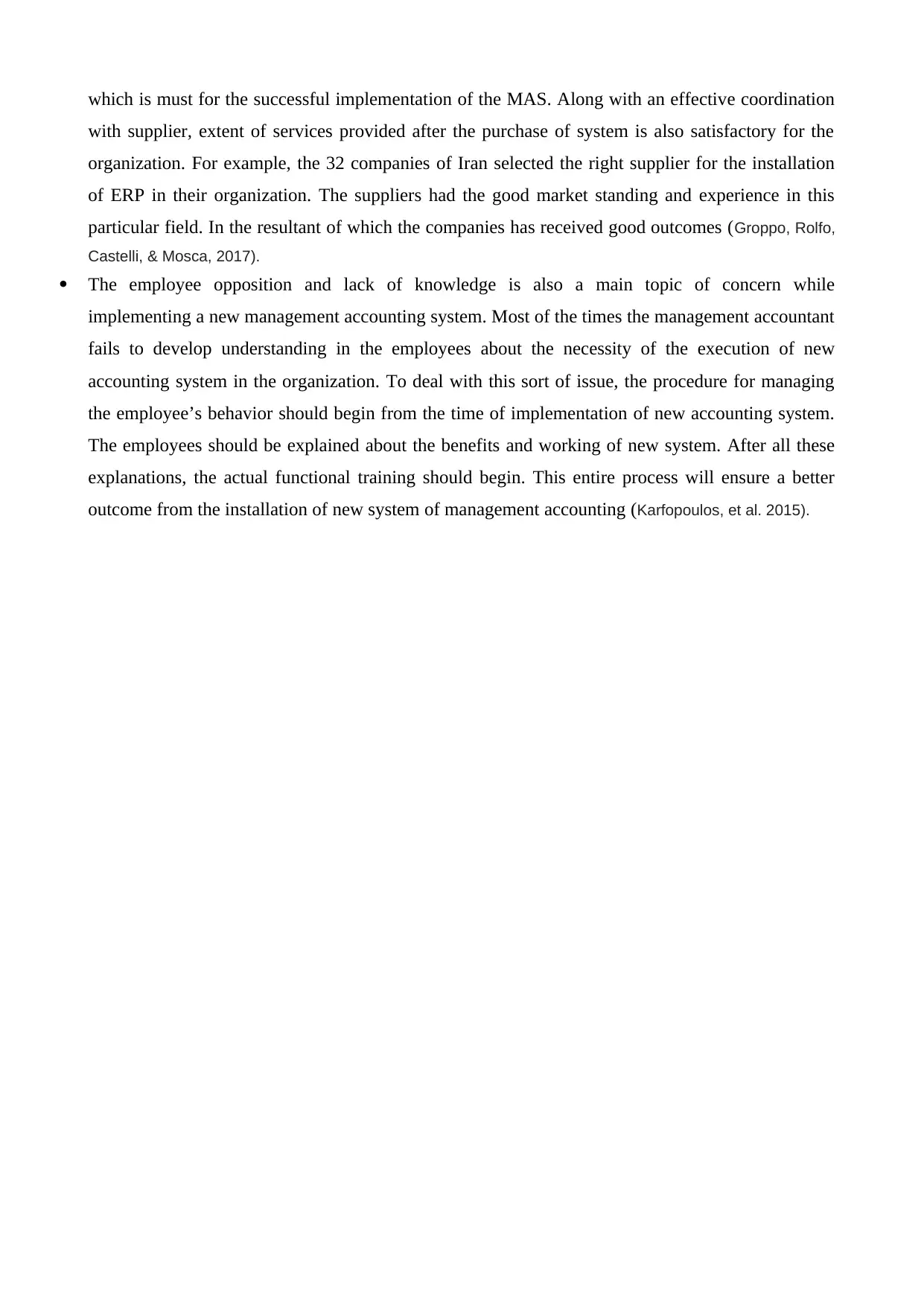
which is must for the successful implementation of the MAS. Along with an effective coordination
with supplier, extent of services provided after the purchase of system is also satisfactory for the
organization. For example, the 32 companies of Iran selected the right supplier for the installation
of ERP in their organization. The suppliers had the good market standing and experience in this
particular field. In the resultant of which the companies has received good outcomes (Groppo, Rolfo,
Castelli, & Mosca, 2017).
The employee opposition and lack of knowledge is also a main topic of concern while
implementing a new management accounting system. Most of the times the management accountant
fails to develop understanding in the employees about the necessity of the execution of new
accounting system in the organization. To deal with this sort of issue, the procedure for managing
the employee’s behavior should begin from the time of implementation of new accounting system.
The employees should be explained about the benefits and working of new system. After all these
explanations, the actual functional training should begin. This entire process will ensure a better
outcome from the installation of new system of management accounting (Karfopoulos, et al. 2015).
with supplier, extent of services provided after the purchase of system is also satisfactory for the
organization. For example, the 32 companies of Iran selected the right supplier for the installation
of ERP in their organization. The suppliers had the good market standing and experience in this
particular field. In the resultant of which the companies has received good outcomes (Groppo, Rolfo,
Castelli, & Mosca, 2017).
The employee opposition and lack of knowledge is also a main topic of concern while
implementing a new management accounting system. Most of the times the management accountant
fails to develop understanding in the employees about the necessity of the execution of new
accounting system in the organization. To deal with this sort of issue, the procedure for managing
the employee’s behavior should begin from the time of implementation of new accounting system.
The employees should be explained about the benefits and working of new system. After all these
explanations, the actual functional training should begin. This entire process will ensure a better
outcome from the installation of new system of management accounting (Karfopoulos, et al. 2015).
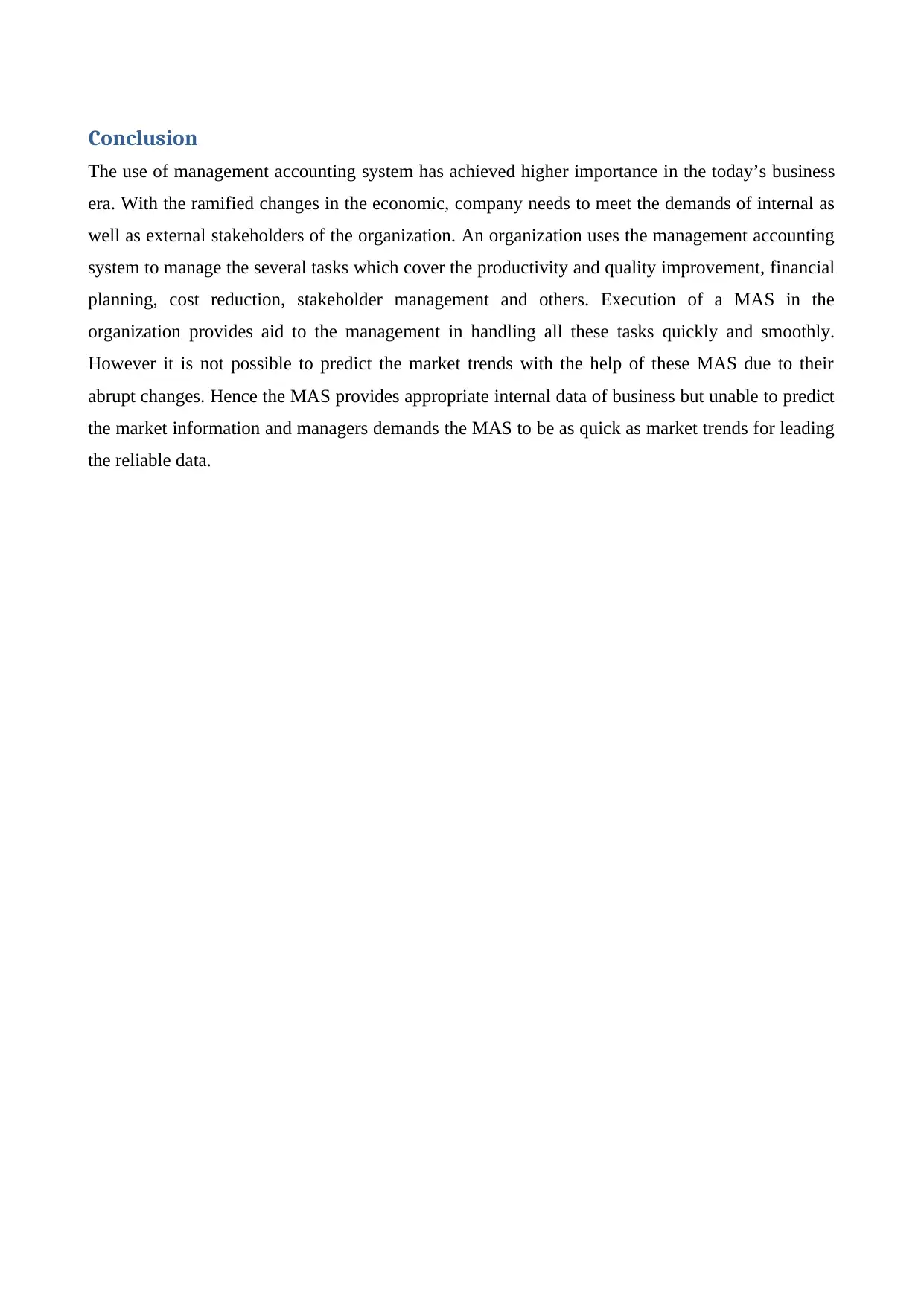
Conclusion
The use of management accounting system has achieved higher importance in the today’s business
era. With the ramified changes in the economic, company needs to meet the demands of internal as
well as external stakeholders of the organization. An organization uses the management accounting
system to manage the several tasks which cover the productivity and quality improvement, financial
planning, cost reduction, stakeholder management and others. Execution of a MAS in the
organization provides aid to the management in handling all these tasks quickly and smoothly.
However it is not possible to predict the market trends with the help of these MAS due to their
abrupt changes. Hence the MAS provides appropriate internal data of business but unable to predict
the market information and managers demands the MAS to be as quick as market trends for leading
the reliable data.
The use of management accounting system has achieved higher importance in the today’s business
era. With the ramified changes in the economic, company needs to meet the demands of internal as
well as external stakeholders of the organization. An organization uses the management accounting
system to manage the several tasks which cover the productivity and quality improvement, financial
planning, cost reduction, stakeholder management and others. Execution of a MAS in the
organization provides aid to the management in handling all these tasks quickly and smoothly.
However it is not possible to predict the market trends with the help of these MAS due to their
abrupt changes. Hence the MAS provides appropriate internal data of business but unable to predict
the market information and managers demands the MAS to be as quick as market trends for leading
the reliable data.
⊘ This is a preview!⊘
Do you want full access?
Subscribe today to unlock all pages.

Trusted by 1+ million students worldwide
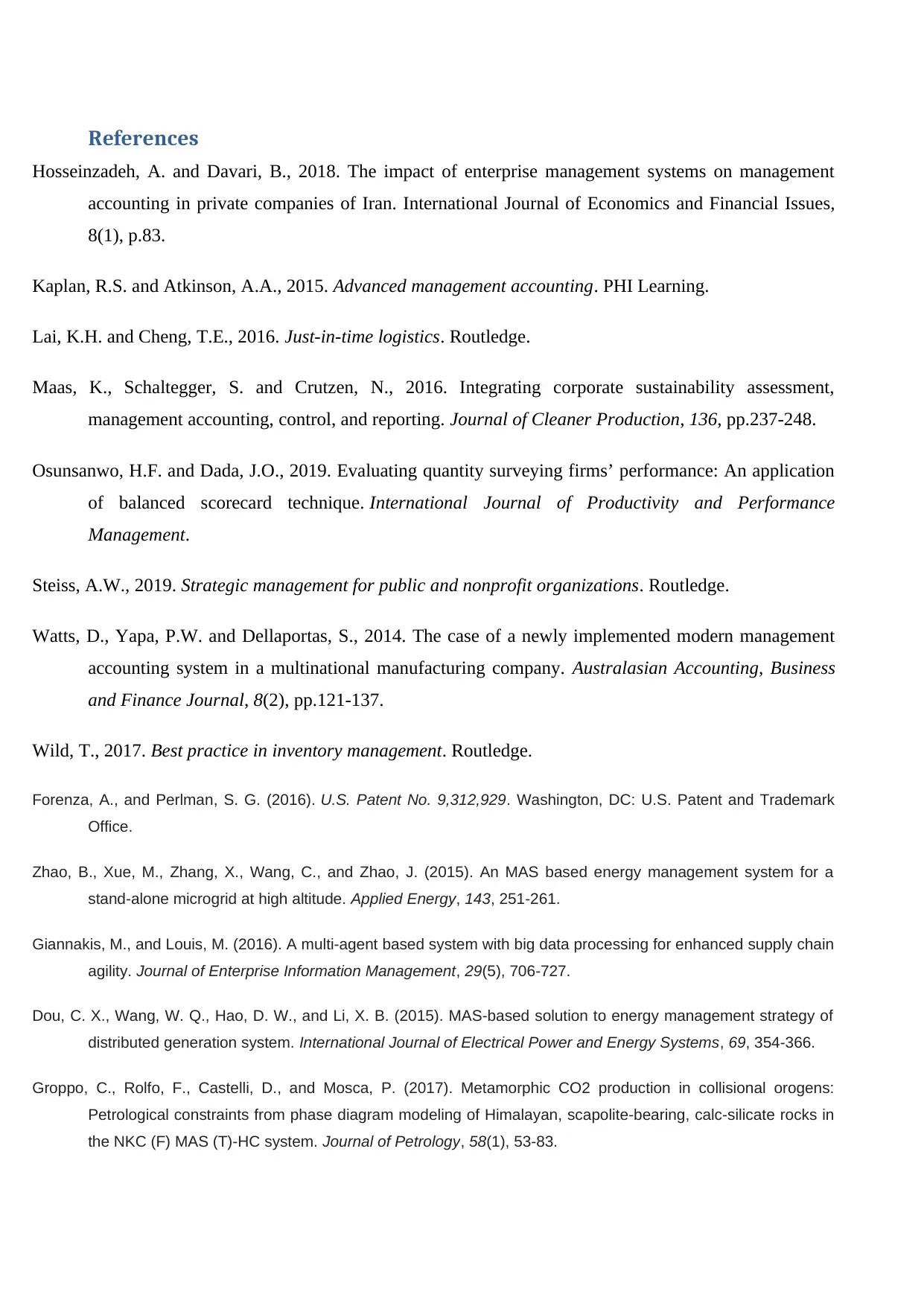
References
Hosseinzadeh, A. and Davari, B., 2018. The impact of enterprise management systems on management
accounting in private companies of Iran. International Journal of Economics and Financial Issues,
8(1), p.83.
Kaplan, R.S. and Atkinson, A.A., 2015. Advanced management accounting. PHI Learning.
Lai, K.H. and Cheng, T.E., 2016. Just-in-time logistics. Routledge.
Maas, K., Schaltegger, S. and Crutzen, N., 2016. Integrating corporate sustainability assessment,
management accounting, control, and reporting. Journal of Cleaner Production, 136, pp.237-248.
Osunsanwo, H.F. and Dada, J.O., 2019. Evaluating quantity surveying firms’ performance: An application
of balanced scorecard technique. International Journal of Productivity and Performance
Management.
Steiss, A.W., 2019. Strategic management for public and nonprofit organizations. Routledge.
Watts, D., Yapa, P.W. and Dellaportas, S., 2014. The case of a newly implemented modern management
accounting system in a multinational manufacturing company. Australasian Accounting, Business
and Finance Journal, 8(2), pp.121-137.
Wild, T., 2017. Best practice in inventory management. Routledge.
Forenza, A., and Perlman, S. G. (2016). U.S. Patent No. 9,312,929. Washington, DC: U.S. Patent and Trademark
Office.
Zhao, B., Xue, M., Zhang, X., Wang, C., and Zhao, J. (2015). An MAS based energy management system for a
stand-alone microgrid at high altitude. Applied Energy, 143, 251-261.
Giannakis, M., and Louis, M. (2016). A multi-agent based system with big data processing for enhanced supply chain
agility. Journal of Enterprise Information Management, 29(5), 706-727.
Dou, C. X., Wang, W. Q., Hao, D. W., and Li, X. B. (2015). MAS-based solution to energy management strategy of
distributed generation system. International Journal of Electrical Power and Energy Systems, 69, 354-366.
Groppo, C., Rolfo, F., Castelli, D., and Mosca, P. (2017). Metamorphic CO2 production in collisional orogens:
Petrological constraints from phase diagram modeling of Himalayan, scapolite-bearing, calc-silicate rocks in
the NKC (F) MAS (T)-HC system. Journal of Petrology, 58(1), 53-83.
Hosseinzadeh, A. and Davari, B., 2018. The impact of enterprise management systems on management
accounting in private companies of Iran. International Journal of Economics and Financial Issues,
8(1), p.83.
Kaplan, R.S. and Atkinson, A.A., 2015. Advanced management accounting. PHI Learning.
Lai, K.H. and Cheng, T.E., 2016. Just-in-time logistics. Routledge.
Maas, K., Schaltegger, S. and Crutzen, N., 2016. Integrating corporate sustainability assessment,
management accounting, control, and reporting. Journal of Cleaner Production, 136, pp.237-248.
Osunsanwo, H.F. and Dada, J.O., 2019. Evaluating quantity surveying firms’ performance: An application
of balanced scorecard technique. International Journal of Productivity and Performance
Management.
Steiss, A.W., 2019. Strategic management for public and nonprofit organizations. Routledge.
Watts, D., Yapa, P.W. and Dellaportas, S., 2014. The case of a newly implemented modern management
accounting system in a multinational manufacturing company. Australasian Accounting, Business
and Finance Journal, 8(2), pp.121-137.
Wild, T., 2017. Best practice in inventory management. Routledge.
Forenza, A., and Perlman, S. G. (2016). U.S. Patent No. 9,312,929. Washington, DC: U.S. Patent and Trademark
Office.
Zhao, B., Xue, M., Zhang, X., Wang, C., and Zhao, J. (2015). An MAS based energy management system for a
stand-alone microgrid at high altitude. Applied Energy, 143, 251-261.
Giannakis, M., and Louis, M. (2016). A multi-agent based system with big data processing for enhanced supply chain
agility. Journal of Enterprise Information Management, 29(5), 706-727.
Dou, C. X., Wang, W. Q., Hao, D. W., and Li, X. B. (2015). MAS-based solution to energy management strategy of
distributed generation system. International Journal of Electrical Power and Energy Systems, 69, 354-366.
Groppo, C., Rolfo, F., Castelli, D., and Mosca, P. (2017). Metamorphic CO2 production in collisional orogens:
Petrological constraints from phase diagram modeling of Himalayan, scapolite-bearing, calc-silicate rocks in
the NKC (F) MAS (T)-HC system. Journal of Petrology, 58(1), 53-83.
Paraphrase This Document
Need a fresh take? Get an instant paraphrase of this document with our AI Paraphraser
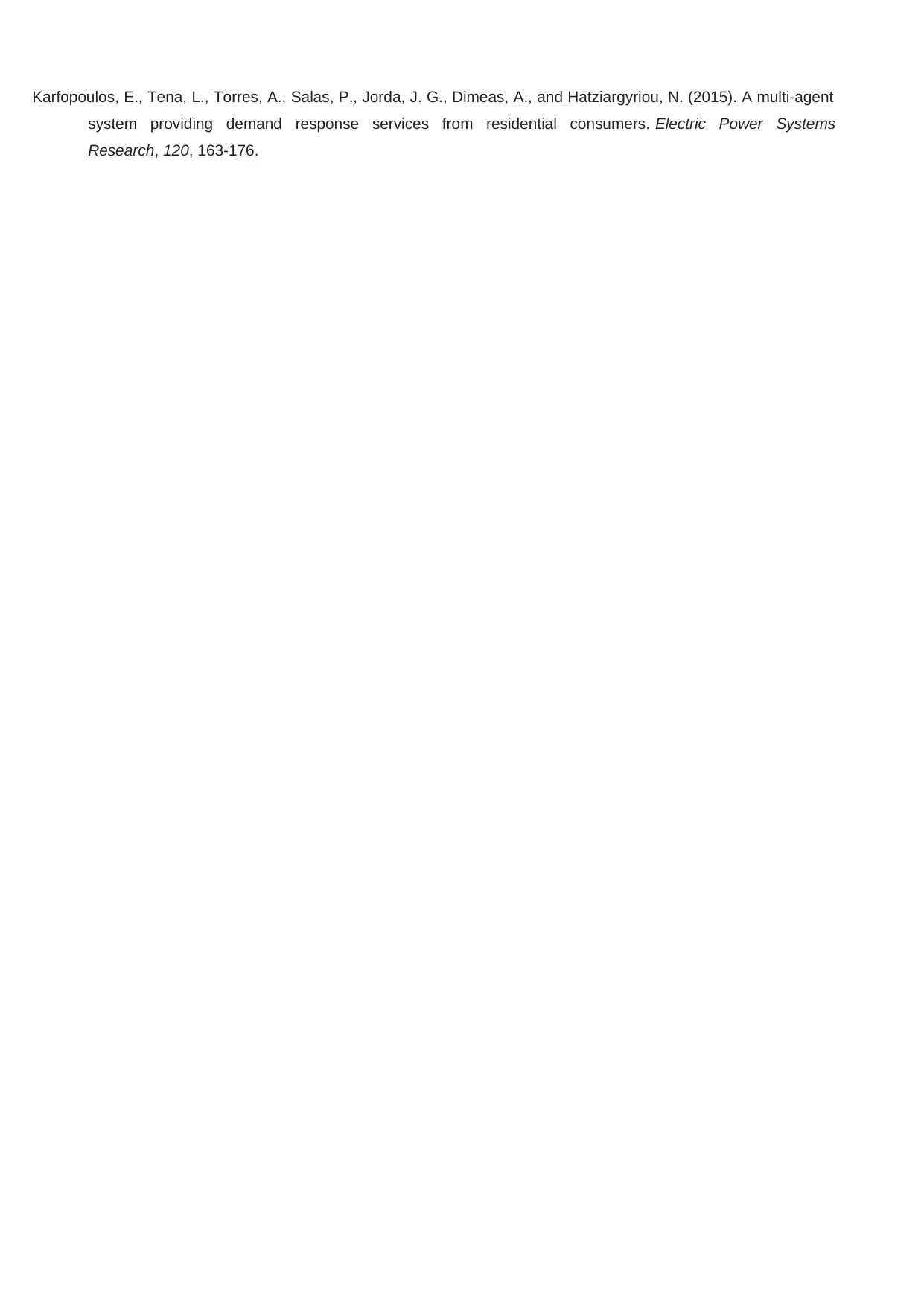
Karfopoulos, E., Tena, L., Torres, A., Salas, P., Jorda, J. G., Dimeas, A., and Hatziargyriou, N. (2015). A multi-agent
system providing demand response services from residential consumers. Electric Power Systems
Research, 120, 163-176.
system providing demand response services from residential consumers. Electric Power Systems
Research, 120, 163-176.
1 out of 11
Related Documents
Your All-in-One AI-Powered Toolkit for Academic Success.
+13062052269
info@desklib.com
Available 24*7 on WhatsApp / Email
![[object Object]](/_next/static/media/star-bottom.7253800d.svg)
Unlock your academic potential
Copyright © 2020–2025 A2Z Services. All Rights Reserved. Developed and managed by ZUCOL.





